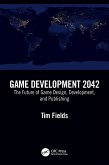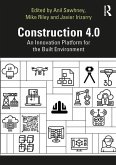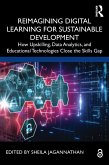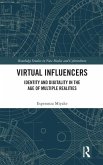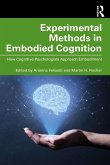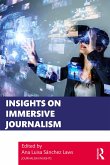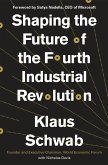Innovative Methods in Korean Language Teaching
Herausgeber: Kiaer, Jieun; Fraschini, Nicola
Innovative Methods in Korean Language Teaching
Herausgeber: Kiaer, Jieun; Fraschini, Nicola
- Broschiertes Buch
- Merkliste
- Auf die Merkliste
- Bewerten Bewerten
- Teilen
- Produkt teilen
- Produkterinnerung
- Produkterinnerung
Innovative Methods in Korean Language Teaching showcases research-based and experience-based contributions and reflections on the potential of adopting technological and non-technological innovations to promote Korean language studentsâ learning.
Andere Kunden interessierten sich auch für
![Game Development 2042 Game Development 2042]() Tim FieldsGame Development 204263,99 €
Tim FieldsGame Development 204263,99 €![Construction 4.0 Construction 4.0]() Construction 4.053,99 €
Construction 4.053,99 €![Reimagining Digital Learning for Sustainable Development Reimagining Digital Learning for Sustainable Development]() Reimagining Digital Learning for Sustainable Development41,99 €
Reimagining Digital Learning for Sustainable Development41,99 €![Virtual Influencers Virtual Influencers]() Esperanza MiyakeVirtual Influencers137,99 €
Esperanza MiyakeVirtual Influencers137,99 €![Experimental Methods in Embodied Cognition Experimental Methods in Embodied Cognition]() Experimental Methods in Embodied Cognition38,99 €
Experimental Methods in Embodied Cognition38,99 €![Insights on Immersive Journalism Insights on Immersive Journalism]() Insights on Immersive Journalism37,99 €
Insights on Immersive Journalism37,99 €![Shaping the Future of the Fourth Industrial Revolution Shaping the Future of the Fourth Industrial Revolution]() Klaus SchwabShaping the Future of the Fourth Industrial Revolution26,99 €
Klaus SchwabShaping the Future of the Fourth Industrial Revolution26,99 €-
-
-
Innovative Methods in Korean Language Teaching showcases research-based and experience-based contributions and reflections on the potential of adopting technological and non-technological innovations to promote Korean language studentsâ learning.
Hinweis: Dieser Artikel kann nur an eine deutsche Lieferadresse ausgeliefert werden.
Hinweis: Dieser Artikel kann nur an eine deutsche Lieferadresse ausgeliefert werden.
Produktdetails
- Produktdetails
- The Korean Wave in Translation
- Verlag: Taylor & Francis Ltd
- Seitenzahl: 200
- Erscheinungstermin: 30. Dezember 2024
- Englisch
- Abmessung: 233mm x 155mm x 14mm
- Gewicht: 336g
- ISBN-13: 9781032725260
- ISBN-10: 1032725265
- Artikelnr.: 71264119
- Herstellerkennzeichnung
- Libri GmbH
- Europaallee 1
- 36244 Bad Hersfeld
- gpsr@libri.de
- The Korean Wave in Translation
- Verlag: Taylor & Francis Ltd
- Seitenzahl: 200
- Erscheinungstermin: 30. Dezember 2024
- Englisch
- Abmessung: 233mm x 155mm x 14mm
- Gewicht: 336g
- ISBN-13: 9781032725260
- ISBN-10: 1032725265
- Artikelnr.: 71264119
- Herstellerkennzeichnung
- Libri GmbH
- Europaallee 1
- 36244 Bad Hersfeld
- gpsr@libri.de
Nicola Fraschini is a senior lecturer at the University of Melbourne Asia Institute, where he is convener of the Korean Studies program and director of the Global Korea Research Hub. His research interests are the psychology of language learners and teachers and Q methodology. Jieun Kiaer is the YBMK KF Professor of Korean Linguistics in the University of Oxford's Asian and Middle Eastern Studies Faculty. She publishes widely on linguistics, Asian studies, and translation. Her recent research covers the future of human language, social media behaviors, big data, and AI linguistics. Wearing the hats of linguist, pragmatist, and Asian specialist, she is uniquely positioned to respond to the recent developments in AI.
Introduction: Innovative methods for global Korean language teaching
NICOLA FRASCHINI AND JIEUN KIAER
PART I: Large language models and Korean language education
1 AI-powered writing assistance: Korean language students' and teachers'
views and experiences
INHYE LEE
2 Students' perceptions of utilizing AI chatbots as conversation partners
for Korean speaking practice: Acceptance, benefits,
and challenges
NA-YOUNG RYU
3 Large language models for Korean grammar and spelling corrections:
comparative evaluation of Bard, Bing, ChatGPT, CLOVA X, and Perplexity AI
NARAE JUNG
4 The potential of generative AI in writing feedback for Korean L2
learners: an analysis on grammar error correction by ChatGPT-3.5 for TOPIK
II writing tasks
KUKJIN KIM
PART II: VR, metaverse, and other technology-based approaches to Korean
language teaching
5 Virtual interactions in Seoul: implementation of highimmersion virtual
reality (HiVR) technology in a Korean language class
JIYOUNG KIM AND SOYEON KIM
6 Exploring the possibilities and limits of metaverse as a Korean teaching
resource: the case of the Sejong Institute's metaverse proposal
ÁLVARO TRIGO MALDONADO
7 Using a YouTube channel as a supplementary language teaching and learning
platform
MYOUNGHEE CHO
PART III: Moving beyond technology for innovation in Korean language
teaching
8 Excitement and confusion: an emotion-based approach to Korean language
teaching
NICOLA FRASCHINI AND YU TAO
9 Multimodal approaches to Korean language teaching
LUCIEN BROWN
10 Transformative learning through critical pedagogy in Korean language
education
YOUNG-MEE YU CHO AND HEE CHUNG CHUN
NICOLA FRASCHINI AND JIEUN KIAER
PART I: Large language models and Korean language education
1 AI-powered writing assistance: Korean language students' and teachers'
views and experiences
INHYE LEE
2 Students' perceptions of utilizing AI chatbots as conversation partners
for Korean speaking practice: Acceptance, benefits,
and challenges
NA-YOUNG RYU
3 Large language models for Korean grammar and spelling corrections:
comparative evaluation of Bard, Bing, ChatGPT, CLOVA X, and Perplexity AI
NARAE JUNG
4 The potential of generative AI in writing feedback for Korean L2
learners: an analysis on grammar error correction by ChatGPT-3.5 for TOPIK
II writing tasks
KUKJIN KIM
PART II: VR, metaverse, and other technology-based approaches to Korean
language teaching
5 Virtual interactions in Seoul: implementation of highimmersion virtual
reality (HiVR) technology in a Korean language class
JIYOUNG KIM AND SOYEON KIM
6 Exploring the possibilities and limits of metaverse as a Korean teaching
resource: the case of the Sejong Institute's metaverse proposal
ÁLVARO TRIGO MALDONADO
7 Using a YouTube channel as a supplementary language teaching and learning
platform
MYOUNGHEE CHO
PART III: Moving beyond technology for innovation in Korean language
teaching
8 Excitement and confusion: an emotion-based approach to Korean language
teaching
NICOLA FRASCHINI AND YU TAO
9 Multimodal approaches to Korean language teaching
LUCIEN BROWN
10 Transformative learning through critical pedagogy in Korean language
education
YOUNG-MEE YU CHO AND HEE CHUNG CHUN
Introduction: Innovative methods for global Korean language teaching
NICOLA FRASCHINI AND JIEUN KIAER
PART I: Large language models and Korean language education
1 AI-powered writing assistance: Korean language students' and teachers'
views and experiences
INHYE LEE
2 Students' perceptions of utilizing AI chatbots as conversation partners
for Korean speaking practice: Acceptance, benefits,
and challenges
NA-YOUNG RYU
3 Large language models for Korean grammar and spelling corrections:
comparative evaluation of Bard, Bing, ChatGPT, CLOVA X, and Perplexity AI
NARAE JUNG
4 The potential of generative AI in writing feedback for Korean L2
learners: an analysis on grammar error correction by ChatGPT-3.5 for TOPIK
II writing tasks
KUKJIN KIM
PART II: VR, metaverse, and other technology-based approaches to Korean
language teaching
5 Virtual interactions in Seoul: implementation of highimmersion virtual
reality (HiVR) technology in a Korean language class
JIYOUNG KIM AND SOYEON KIM
6 Exploring the possibilities and limits of metaverse as a Korean teaching
resource: the case of the Sejong Institute's metaverse proposal
ÁLVARO TRIGO MALDONADO
7 Using a YouTube channel as a supplementary language teaching and learning
platform
MYOUNGHEE CHO
PART III: Moving beyond technology for innovation in Korean language
teaching
8 Excitement and confusion: an emotion-based approach to Korean language
teaching
NICOLA FRASCHINI AND YU TAO
9 Multimodal approaches to Korean language teaching
LUCIEN BROWN
10 Transformative learning through critical pedagogy in Korean language
education
YOUNG-MEE YU CHO AND HEE CHUNG CHUN
NICOLA FRASCHINI AND JIEUN KIAER
PART I: Large language models and Korean language education
1 AI-powered writing assistance: Korean language students' and teachers'
views and experiences
INHYE LEE
2 Students' perceptions of utilizing AI chatbots as conversation partners
for Korean speaking practice: Acceptance, benefits,
and challenges
NA-YOUNG RYU
3 Large language models for Korean grammar and spelling corrections:
comparative evaluation of Bard, Bing, ChatGPT, CLOVA X, and Perplexity AI
NARAE JUNG
4 The potential of generative AI in writing feedback for Korean L2
learners: an analysis on grammar error correction by ChatGPT-3.5 for TOPIK
II writing tasks
KUKJIN KIM
PART II: VR, metaverse, and other technology-based approaches to Korean
language teaching
5 Virtual interactions in Seoul: implementation of highimmersion virtual
reality (HiVR) technology in a Korean language class
JIYOUNG KIM AND SOYEON KIM
6 Exploring the possibilities and limits of metaverse as a Korean teaching
resource: the case of the Sejong Institute's metaverse proposal
ÁLVARO TRIGO MALDONADO
7 Using a YouTube channel as a supplementary language teaching and learning
platform
MYOUNGHEE CHO
PART III: Moving beyond technology for innovation in Korean language
teaching
8 Excitement and confusion: an emotion-based approach to Korean language
teaching
NICOLA FRASCHINI AND YU TAO
9 Multimodal approaches to Korean language teaching
LUCIEN BROWN
10 Transformative learning through critical pedagogy in Korean language
education
YOUNG-MEE YU CHO AND HEE CHUNG CHUN


